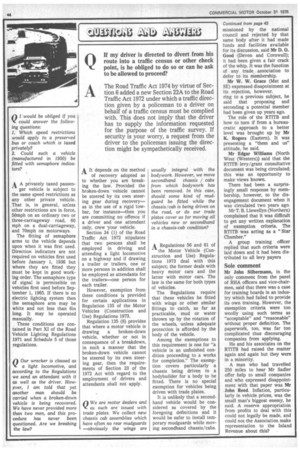Q We are motor dealers and as such are issued with
Page 46

If you've noticed an error in this article please click here to report it so we can fix it.
trade plates. We collect new chassis cab assemblies which have often no rear mudguards —obviously the wings are usually integral with the bodywork. However, we move secondhand chassis / cabs from which bodywork has been removed. In this case, should some kind of mudguard be fitted while the chassis/cab is being driven on the road, or do our trade plates cover us for moving all vehicles new or secondhand in a chassis-cab condition?
A Regulations 56 and 61 of the Motor Vehicle (Construction and Use) Regulations 1973 deal with this subject; the former deals with heavy motor cars and the latter with motor cars. The law is the same for both types of vehicles.
The Regulations require that these vehicles be fitted with wings or other similar fittings to catch, as far as practicable, mud or water thrown up by the rotation of the wheels, unless adequate protection is afforded by the body of the vehicle.
Among the exemptions to this requirement is one for "a vehicle in an unfinished condition proceeding to a works for completion." The exemption covers particularly a chassis being driven to a bodybuilder for a body to be fitted. There is no special exemption for vehicles being driven with trade plates.
It is unlikely that a secondhand vehicle would be considered as covered by the foregoing definitions and it would be safer to install temporary mudguards while moving secondhand chassis/cabs.
































































































